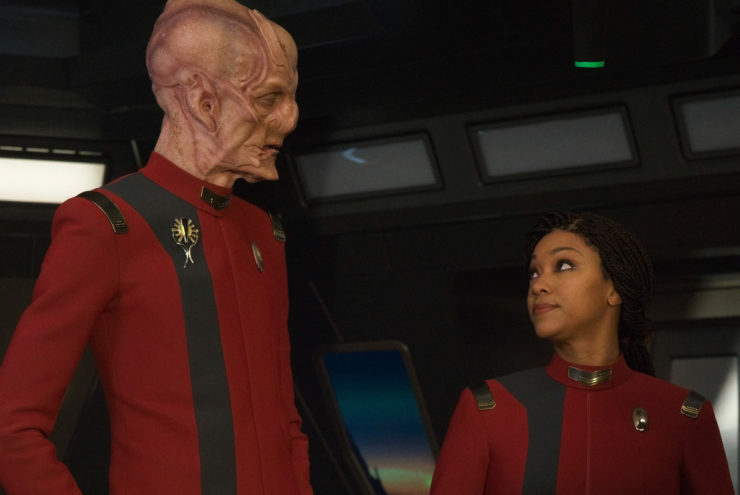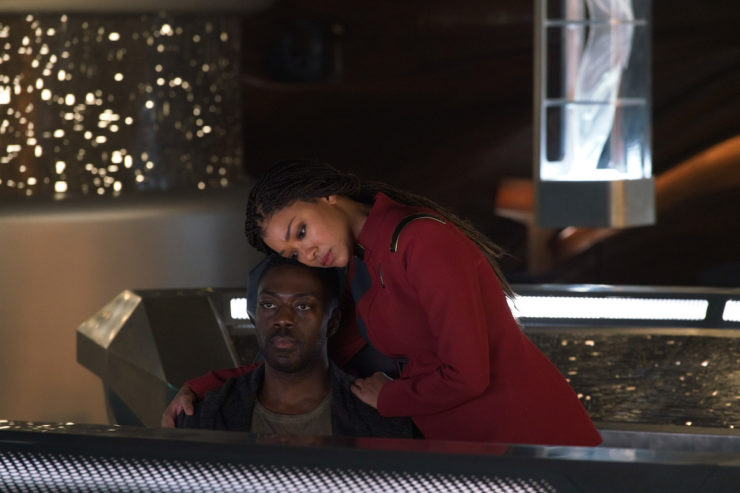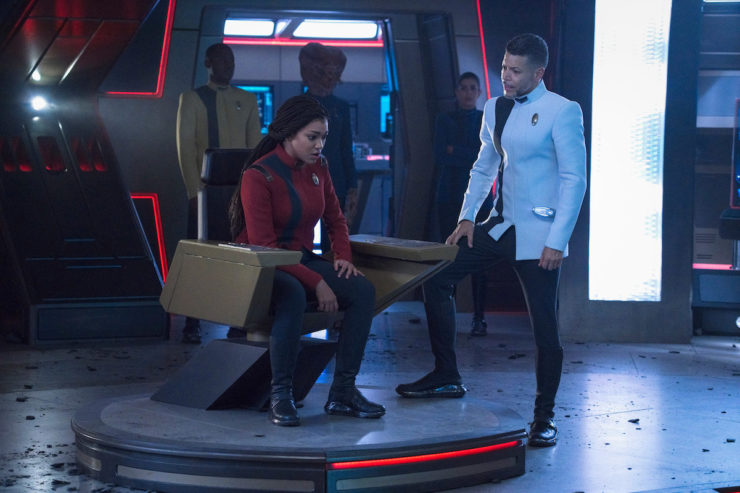Star Trek has, historically, been really really terrible with consequences.
On the original series, Kirk was present for the deaths of several important people to him: his best friend, his brother and sister-in-law, and two of the great loves of his life, one of whom was pregnant with his child. Yet he was never seen to feel any trauma beyond the episodes where those things happened.
And it wasn’t much better in the first wave of spinoffs. But if the trend toward serialization has given us nothing else, it’s given us TV writers who are willing to examine long-term consequences.
All the Trek shows prior to 2017 were generally awful at showing consequences of actions beyond the episodes in which they took place. In TNG, Picard’s living someone else’s life for 35 subjective years had basically no effect on him, ditto being tortured, while La Forge’s brainwashing by the Tal Shiar similarly had no long-term impact on him. In DS9, which generally was pretty good about it, we still had O’Brien suffering all kinds of trauma with no real followup after the episode where it happened. Voyager was hilariously awful at showing consequences, with the most egregious being Tuvok and Neelix showing no repercussions from being combined into a single being.
Not that they were always as bad as the original series was. For example, things like Picard’s assimilation by the Borg and Worf’s discommendation from the Klingon Empire continued to be recurring issues for both, in the latter through both TNG and DS9.
Discovery, however, has proven to be much much better at it, from things like Georgiou’s death continuing to have an impact on Burnham’s behavior to the effect Airiam’s death had on the crew to Detmer’s PTSD after coming to the thirty-second century.
“Anomaly” is chock full of consequences, and while the most impressive one is what is suffered by Book, I want to take a moment to talk about how very brilliantly we saw Tilly and Adira being affected by the death of Commander Nalas last week. Nalas is exactly the kind of guest character whose death moves the plot along but who is generally forgotten, often before the episode is even over much less beyond it. So it’s incredibly heartening to see that Nalas’ manipulative death was manipulating us for a reason. Tilly is having trouble processing it, and her conversations with both Saru and Culber are strong examinations of Tilly’s trauma at watching him die after trying to rescue him.

But the biggies are Book and Stamets, the former suffering from his homeworld being destroyed last week, the latter from the events at the end of last season.
First of all, David Ajala gives the performance of a lifetime here. Book’s devastation is etched on Ajala’s every pore. Secondly, Sonequa Martin-Green does a good job of showing Burnham’s conflict here, as her personal relationship with Book is affecting her decision-making—which is why you shouldn’t be in command of your loved ones. (Ah, television…) Saru makes a good sounding board here, because he can see objectively that Book is right in the abstract: he is the best person for the job.
The job in question is the driving force of the plot, as the titular anomaly is the gravitational thingamajiggers that destroyed both the Deep Space Repair Station Beta 6 and Kwejian last week. Discovery is sent to examine it, and the only way to get decent readings is to send in Book’s ship, which is smaller, more maneuverable, and can alter its shape—and Book is also the one most qualified to pilot the ship. Burnham’s instinct is to have Detmer fly the ship—and it’s mine, too, as Detmer is a better pilot than Book, but Book does know his ship better, especially given Detmer’s relative lack of experience with programmable matter.
Buy the Book


You Sexy Thing
And yes, Saru is her sounding board, because of the one plot point in this episode that actively pissed me off: Saru, while still holding the rank of captain, has been offered his own command (of the U.S.S. Sojourner), but has instead chosen to return to Discovery as Burnham’s first officer. He’s doing it because he feels that Burnham needs his counsel as Number One in much the same way that Saru needed hers when he was in command.
It’s maddening because, on the one hand, this is a hundred percent in character for Saru, who is very much the type to put someone else’s needs ahead of his own for the greater good. And, all things being equal, Saru will be excellent in the role, as indeed he is in this episode.
But Saru’s a fucking captain, and he really should have his own command. In a show that has mostly moved past some of the dopey clichés of television—like the lack of consequences—it’s still trapped by the tyranny of the opening credits. It’s also why Kirk’s and Picard’s crew stayed in the same positions despite advancing in rank through the first ten movies, and it’s absurd. The only reason Saru is taking a demotion to be Burnham’s first officer is because Doug Jones is still the second-billed star of the show.

Mind you, it’s great seeing Saru back on board, and Jones plays him with his usual mix of brilliance and compassion. But he really doesn’t belong on the ship anymore—or Burnham doesn’t, one or the other.
(I do like that they come to a compromise on what to call him, since referring to him by rank would be confusing—they settle on “Mr. Saru,” which is perfect.)
The other trauma in this episode alongside Book’s is Stamets’, and this one threw me for a loop, but it works. Apparently, he and Burnham have kissed and made up over her tossing him out of Discovery last season—Stamets makes a vaguely tasteless too-soon joke about it, and that’s a tale that I hope some work of tie-in fiction tackles at some point, because there’s a story there, dammit—but the engineer is still suffering other trauma.
At the end of last season, Book was able to do something that previously only Stamets could do: operate the spore drive. He was able to save Adira and Culber (and Gray), where Stamets couldn’t.
His conversations with Book are fraught and fascinating. Stamets—who is on Book’s ship as a hologram so he can run the scans, but be safe back on Discovery—tries to be friendly to Book, but it’s awkward as hell, and they get pretty snippy with each other. But eventually, Stamets admits to what his problem with Book is: that he’s jealous that Book could save his family when Stamets himself couldn’t.
It’s also worth noting that Book is obviously suicidal in this episode. At one point, he tells Stamets to return to his body with the data and leave him be in the anomaly, and the way Ajala played it, it very much plays like he wants to let the anomaly take him the way it took Kwejian. Only when Stamets tells him that the data is in the ship’s databanks and can’t be transferred to Discovery due to interference does he prove willing to go back. And even then, navigating the anomaly proves difficult—he has to rely on Burnham telling him when to go and ride some distortion waves (a notion provided by Lt. Commander Bryce). The first time, he hesitates, and that solidified the suicidal notion to me. Burnham has to pretty much talk him down off the roof to get him to come back.
Both Anthony Rapp and especially Ajala play all of this so incredibly well. Book isn’t out of the woods, yet, but at least he’s processing his trauma and hopefully won’t try to kill himself again. It helps that both Burnham and Stamets don’t give up on him.

In the end, they get some data on the anomaly, but mostly it just raises more questions, as it doesn’t behave in any manner that the science nerds on Discovery can predict. As usual, the crew of Discovery is at its best when science-ing the shit out of something, and those are some of the best moments in the episode, particularly when Tilly and Adira are trying to figure out how to get Book’s ship out of the anomaly.
(It’s also fun watching Tilly grow into a more together officer, only to find herself being hero-worshipped by Adira, who’s acting very much like first-season Tilly, and it’s just adorable…)
Speaking of Adira, they’re also on the verge of getting Gray his own body. Using the same technique that enabled Picard’s life to be saved at the end of Picard‘s first season (which was specifically referenced by Culber), the process is said to have a low success rate generally. However, Gray’s consciousness having been transferred successfully before means the likelihood of it going well is pretty high here.
Besides dealing with multiple traumas and finding out more about the anomaly, we get a look at the thirty-second-century version of a holodeck, as Burnham is able to alter the environment in her quarters to make it seem like she’s on Ni’Var, specifically a locale she remembers from her childhood. (I love that both Saru and Burnham refer to the world by its new name, not the one they knew from the twenty-third century, and that the viewers are still more likely to remember—though its former identity as Vulcan is mentioned, just in case…)
Ni’Var’s president is also back, as she’s part of the big meeting about the anomaly at Starfleet HQ that also includes Vance, several other captains (including a Ferengi!), and President Rillak. It’s always good to see Tara Rosling’s President T’Rina, and I hope we see lots more of her as the season goes on, as she was my favorite new character last year.
This episode stands on its own less successfully than “Kobayashi Maru” did, but it does also have a beginning, a middle, and an end, while setting up lots of things for the future: Book’s ongoing trauma, Tilly’s desire for therapy with Culber, Gray’s new body, the reintegration of the Federation, and, of course, the ongoing question of what the anomaly is.
Keith R.A. DeCandido wishes everyone a happy Thanksgiving. He is very thankful to everyone who reads his work here on Tor.com, and to the folks at Tor.com for hosting his work. And don’t forget to listen to “Alice’s Restaurant” at noon…










